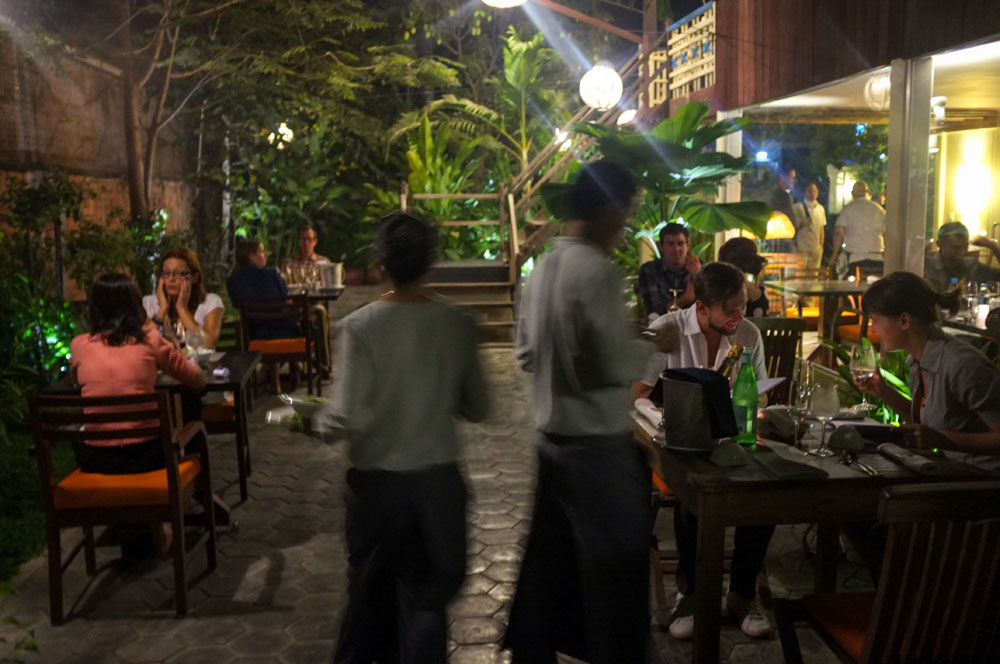
The remork taxi takes me the back route to Cuisine Wat Damnak. I jiggle unflatteringly down an unpaved road in the dusk, through a quiet neighbourhood that feels distant from the “fish-foot-massage-no-piranha!” joints that line the streets at the centre of Siem Reap. I fear we’ve gone the wrong way, which only adds to the sense of welcome when we draw up outside a beautiful old wooden Khmer house – stilted and high-ceilinged – a calm, gently-lit, open space.
I discover it’s actually three spaces, the first of which I encounter when I’m led upstairs to the balcony for a pre-dinner cocktail. This floor has been done in the traditional Khmer style, all low dark-wood furniture and giant softly-whirring ceiling fans, which I don’t happen to need, as I’m being wholly revived by my Holy Basil Martini. In Cambodia, a cocktail is usually a better choice than distantly imported wine. Flavours can be found locally – a central concern for the owners of this restaurant – and the zing of the lemongrass and the kick of ginger, mixed with the cool aniseed of Asian basil seem like a tonic to the heat of the day.
I have a little time to peruse the menu while we sip. I had been apprehensive when I heard it was a French chef who’d set up kitchen here: after a long sweaty day’s temple-climbing, I don’t want to be faced with a huge pan-fried foie gras or a mountain of puy lentils (dishes I’ve encountered in other French-run places in town), however well executed. But the list is reassuringly goose-liver free, and anyway, I’ve recently learned that Joannès Rivière is in fact Cambodian food’s biggest advocate. He’s written the book about it. He’s run a school for young disadvantaged Cambodians teaching how best to exploit it. He is reputed to be thoroughly immersed in what the jungles, lakes and rivers of this small country have to offer.
Down in the simple, modern, dining room, we discover the cuisine that springs from Rivière’s dedication to all things local. There is a choice of two tasting menus consisting of five courses, one priced at US$17 and the other at $24. Menus change weekly, depending on the availability of seasonal ingredients. Both of the current ones are equally alluring to me. Here, where prices are so low, you have the freedom to let your tastebuds, not your wallet, decide…
Today’s amuse-bouche is a spoonful of tender sweet-and-sour corn kernels, followed by a salad of supremely tender chicken and calamari served on a bed of local herbs, which is simple, refreshing and pretty. I have pork shank next, braised with just enough caramelised palm sugar to make it luscious but not cloying. A dash of star anise that gives it depth of flavour, but avoids overwhelming the dish with gobstoppery aniseed. The pork is served with lotus root, which I find a foodstuff of form over content – the exciting space-invader shape belying a disappointing blandness, though Wat Damnak do a good job of rendering it palatable.
He’s French, yet modest; he is also knowledgeable, and adamant that it’s talking to locals to find the very best suppliers for his ingredients that makes the restaurant successful.
I pause a moment before tucking in to the fish course that follows – Tonle Sap Croaker fish with pounded wild eggplant and local cress. Yesterday I visited the vast Tonle Sap lake, which sits at the heart of the country, and is an indispensable source of protein for most of Cambodia’s population. To get there, I travelled past the spindle-stilted towns that line its banks and, via boat, drifted among those who live in floating villages on the water – who feed from the lake, sleep on the lake and wash their clothes in the lake. I have a flash of concern about what the bottom-dwelling croaker fish might have fed on. But then, such preciousness seems silly when you consider what runs off from British factory and farmlands into our own fresh water. As for issues of sustainability, if family-based fishing continues to be dominant here, rather than rapacious conglomerates taking over completely, then fish should continue to thrive. This one tastes like it has thrived: its flesh is sweet and firm (and doesn’t taste of Persil), and contrasts nicely with the pepperiness of the cress.
If anyone is going to be careful about the supply line, it’s Joannès. He leaves the kitchen briefly to find out how his evening’s guests are faring. He’s French, yet modest; he is also knowledgeable, and adamant that it’s talking to locals to find the very best suppliers for his ingredients that makes the restaurant successful.
I finish the evening with dessert in the last of the three dining areas – the garden – surrounded by herbs that will, I’m sure, find their way into next week’s menu. My chilled fruit soup and lime sorbet with green tea is simple, reviving and its colours look beautiful together. Each dish has been stylish without seeming preened.
It is rare to find the particular combination of technical expertise and zest for the use of unusual, local ingredients that Cuisine Wat Damnak offers. As I linger over a final “surprise” dish of sour fruits and sherbet, I reflect that if you add sheer value for money to the mix, it’s unlikely that I’ll have a similar experience again.
Cuisine Wat Damnak, Between Psa Dey Hoy market and Angkor High School,
Wat Damnak village, Sala Kamrek Commune, Siem Reap, Cambodia
(0)63 965 491; cuisinewatdamnak.com


